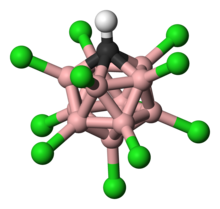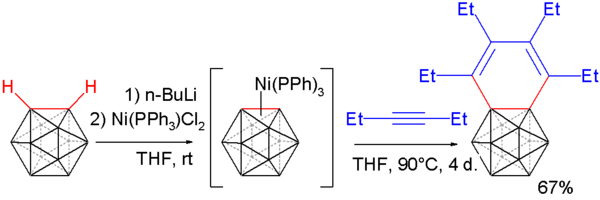碳硼烷

碳硼烷是由硼和碳形成的原子簇化合物。如同硼烷一般,碳硼烷的分子结构也是多面体,并依据构造同样分类为closo-(闭合式)、nido-(缺少一个顶点)、arachno-(缺少两个顶点)、hypho-(缺少三个顶点)等等。
代表化合物[编辑]

碳硼烷的一个特殊例子,为极端稳定的正二十面体闭合式碳硼烷。[1] 而其中重要的例子为电中性的C2B10H12,即邻-碳硼烷(o-carborane),其在广泛的应用领域如耐热聚合物与医学应用上均有所研究。由于此化合物符合休克尔规则,具有高度的芳香性,而且对热相当稳定。邻-碳硼烷在420°C转变为间-碳硼烷,而苯需要加热至1000°C以上才能发生结构重组。如同芳香烃一般,碳硼烷亦可发生亲电芳香取代反应。
另一个重要的碳硼烷为带负电的CHB11H12−阴离子,被用来制备固态的超强酸。
二碳代十二硼烷[编辑]
被研究最多的碳硼烷是C2B10H12(熔点320°C)。此化合物通常由乙炔与癸硼烷合成。此外,也可以丁炔二醇二乙酸酯作原料,使产生的C2B10H10(O2CCH3)2分解生成C2B10H12。[2]
历史[编辑]
1,2-闭合式-二碳代十二硼烷(即邻-碳硼烷,通常直接称为碳硼烷),是同时被Olin Corporation的团队以及美国空军旗下Thiokol化工厂的Reaction Motors Division所发现的,并发表于1963年。[3][4][5][6][7][8][9][10][11] 同时苏联的一个团队也发表了类似的成果。在此之前,癸硼烷衍生物被认为对热不稳定,而且会与水和空气反应,但这些团队证实了1,2-闭合式-二碳代十二硼烷空前的稳定性,并发表了一般性的合成方法,不破坏碳硼烷核心下取代基的转化,以及邻位至间位的异构化反应。
二碳代十一硼烷阴离子[编辑]
化学家对二碳代十一硼烷根阴离子[B9C2H11]2−做了许多研究。此阴离子与许多金属离子形成夹心配合物,而且许多此类化合物当中,金属离子呈现不寻常的氧化态。此离子呈巢型簇结构,可由母化合物二碳代十二硼烷分解产生:[12]
- B10C2H12 + 3 CH3OH + KOH → KB9C2H12 + B(OCH3)3 + H2O + H2
碳硼炔[编辑]
碳硼炔又称1,2-去氢-邻-碳硼烷(1,2-dehydro-o-carborane),是邻-碳硼烷的一种不稳定衍生物,其化学式为B10C2H10。其与碳硼烷的差别,在于两个相邻碳原子上不具有氢。此化合物与苯炔相似并具有等瓣结构。[13][14][15] 第一个碳硼炔化合物于1990年由碳硼烷制备而成。碳上的氢离子使用四氢呋喃中的正丁基锂移除,而产生的双阴离子锂盐再于0°C下与溴反应,生成溴化单阴离子。
将反应混合物加热至35°C释放出碳硼炔,并使用合适的二烯以狄尔斯-阿尔德反应捕捉:
亦可与呋喃和蒽(产生类似三螺烯的化合物)反应,收率为10至25%。
碳硼炔亦可使用上述反应的修改方式与炔烃反应,产生苯并碳硼烷。[16][17] 首先使用正丁基锂移除碳硼烷上的质子,并与二氯-双(三苯膦)镍反应产生碳硼炔的镍错合物。此化合物再与3-己炔反应,经由炔烃三聚反应产生苯并碳硼烷。
单晶X射线衍射分析显示,此化合物苯环的键长有明显的交替现象,显示该化合物的苯环不具芳香性。
碳硼烷酸[编辑]

用色:氢-白、氯-绿、硼-粉红、碳-黑
碳硼烷酸H(CHB11Cl11)[18] 为一种超强酸,是最强的单一分子酸,酸性为硫酸的一百万倍、氟磺酸的数百倍。
历史[编辑]
2004年,加州大学河滨校区(UC Riverside)的Chris Reed团队首先合成出碳硼烷酸。[19]
特性[编辑]
造成碳硼烷酸超强酸性的原因,是由于其共轭碱CHB11Cl11−非常稳定,而且具有高电负性的氯取代基,能有效分散负电荷。而外侧的氯包覆碳硼烷核心,使碳硼烷酸根非常安定,不易与其他化学物质反应。
碳硼烷酸虽然酸性强,但不具强烈的腐蚀性与氧化性。混合酸如魔酸、氟锑酸酸性更强,但会生成氟离子造成副反应,而且产生的氢氟酸成分会腐蚀玻璃,造成使用上的困难。而且氟会攻击富勒烯,故H(CHB11Cl11)成为已知唯一能质子化富勒烯但不会将其分解的酸,能与富勒烯形成1:1的盐类。[20][21]
参考资料及注释[编辑]
- ^ Eluvathingal D. Jemmis. Overlap control and stability of polyhedral molecules. Closo-Carboranes. J. Am. Chem. Soc. 1982, 104: 7017–7020. doi:10.1021/ja00389a021.
- ^ Kutal, C. R.; Owen, D. A.; Todd, L. J. Closo-1,2-dicarbadodecaborane(12). Inorganic Syntheses. 1968, 11: 19–23. doi:10.1002/9780470132425.ch5.
- ^ T. L. Heying, J. W. Ager, S. L. Clark, D. J. Mangold, H. L. Goldstein, M. Hillman, R. J. Polak, and J. W. Szymanski. A New Series of Organoboranes. I. Carboranes from the Reaction of Decaborane with Acetylenic Compounds. Inorganic Chemistry. 1963, 2: 1089 – 1092. doi:10.1021/ic50010a002.
- ^ H. Schroeder, T. L. Heying, J. R. Reiner. A New Series of Organoboranes. II. The Chlorination of 1,2-Dicarbaclosododecaborane(12)" Inorganic Chemistry. Inorganic Chemistry. 1963, 2: 1092 – 1096. doi:10.1021/ic50010a003.
- ^ T. L. Heying, J. W. Ager, S. L. Clark, R. P. Alexander, S. Papetti, J. A. Reid, S. I. Trotz. A New Series of Organoboranes. III. Some Reactions of 1,2-Dicarbaclosododecaborane(12) and its Derivatives. Inorganic Chemistry. 1963, 2: 1097 – 1105. doi:10.1021/ic50010a004.
- ^ S. Papetti, T. L. Heying. A New Series of Organoboranes. IV. The Participation of the 1,2-Dicarbaclosododecaborane(12) Nucleus in Some Novel Heteratomic Ring Systems. Inorg. Chem. 1963, 2: 1105–1107. doi:10.1021/ic50010a005.
- ^ M. M. Fein, J. Bobinski, N. Mayes, N. Schwartz, M. S. Cohen. Carboranes. I. The Preparation and Chemistry of 1-Isopropenylcarborane and its Derivatives (a New Family of Stable Closoboranes). Inorg. Chem.]] 1963, 2: 1111 – 1115. doi:10.1021/ic50010a007.
- ^ M. M. Fein, D. Grafstein, J. E. Paustian, J. Bobinski, B. M. Lichstein, N. Mayes, N. N. Schwartz, M. S. Cohen. Carboranes. II. The Preparation of 1- and 1,2-Substituted Carboranes. Inorg. Chem. 1963, 2: 1115 – 1119. doi:10.1021/ic50010a008.
- ^ D. Grafstein, J. Bobinski, J. Dvorak, H. Smith, N. Schwartz, M. S. Cohen, M. M. Fein. Carboranes. III. Reactions of the Carboranes. Inorg. Chem. 1963, 2: 1120 – 1125. doi:10.1021/ic50010a009.
- ^ D. Grafstein, J. Bobinski, J. Dvorak, J. E. Paustian, H. F. Smith, S. Karlan, C. Vogel, M. M. Fein. Carboranes. IV. Chemistry of Bis-(1-carboranylalkyl) Ethers. Inorg. Chem. 1963, 2: 1125 – 1128. doi:10.1021/ic50010a010..
- ^ D. Grafstein, J. Dvorak. Neocarboranes, a New Family of Stable Organoboranes Isomeric with the Carboranes. Inorg. Chem. 1963, 2: 1128 – 1133. doi:10.1021/ic50010a011.
- ^ Plešek, J.; Heřmánek, S.; Štíbr, B. Inorganic Syntheses, 1983, volume 22, pages 231-124.
- ^ Henry L. Gingrich, Tirthankar Ghosh, Qiurong Huang, and Maitland Jones. 1,2-Dehydro-o-carborane. J. Am. Chem. Soc. 1990, 112 (10): 4082 – 4083. doi:10.1021/ja00166a080.
- ^ E. D. Jemmis and B. Kiran. Structure and Bonding in B10X2H10 (X = C and Si). The Kinky Surface of 1,2-Dehydro-o-Disilaborane. J. Am. Chem. Soc. 1997, 119 (19): 4076–4077. doi:10.1021/ja964385q.
- ^ B. Kiran, A. Anoop, E. D. Jemmis. Control of Stability through Overlap Matching: closo-Carboranes and closo-Silaboranes. J. Am. Chem. Soc. 2002, 124: 4402–4407. doi:10.1021/ja016843n.
- ^ Liang Deng, Hoi-Shan Chan, and Zuowei Xie. Nickel-Mediated Regioselective [2 + 2 + 2] Cycloaddition of Carboryne with Alkynes. J. Am. Chem. Soc. 2006, 128 (24): 7728 – 7729. doi:10.1021/ja061605j.
- ^ Eluvathingal D Jemmis and Anakuthil Anoop. Theoretical Study of the Insertion Reactions of Benzyne- and Carboryne- Ni Complexes (PDF). MHPCC Application Briefs. 2004: 51. (原始内容 (PDF)存档于2006-07-13).
- ^ 注意在图片中,酸性氢并不是键结在碳硼烷分子的氢,而是平衡离子
- ^ Juhasz, M.; Hoffmann, S.; Stoyanov, E.; Kim, K.-C.; Reed, C. A. (2004). Angew. Chem., Int. Ed. 43: 5352-5355. DOI: 10.1002/anie.200460005.
- ^ Mark Juhasz, Stephan Hoffmann, Evgenii Stoyanov, Kee-Chan Kim, Christopher A. Reed. The Strongest Isolable Acid. Angewandte Chemie International Edition (Communication). 2004, 43: 5352 – 5355. doi:10.1002/anie.200460005.
- ^ Christopher A. Reed. Carborane acids. New "strong yet gentle" acids for organic and inorganic chemistry (PDF). Chem. Commun. 2005, 2005: 1669–1677 [2008-05-29]. doi:10.1039/b415425h. (原始内容 (Full article (reprint))存档于2020-05-11).
外部链接[编辑]
|



